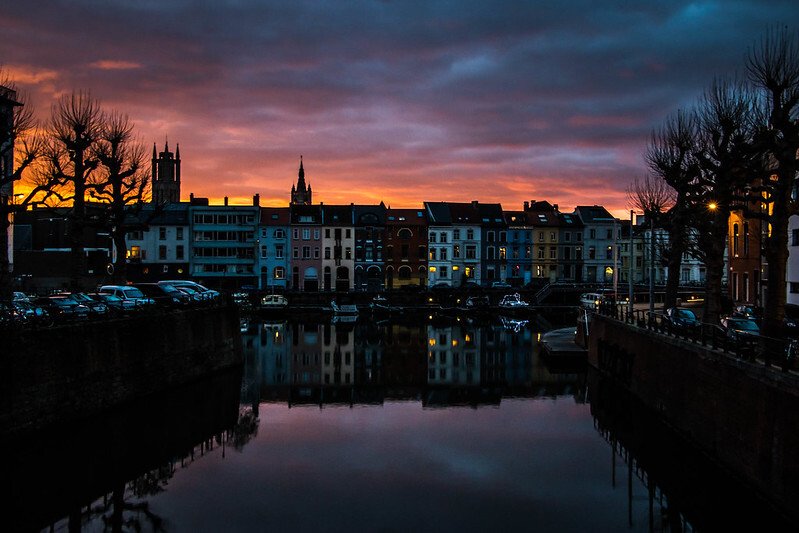The Low Countries is a coastal lowland region in Northwestern Europe forming the lower basin of the Rhine–Meuse–Scheldt delta and consisting today of Belgium, Luxembourg, and the Netherlands. Geographically and historically, the area also includes parts of France and Germany such as French Flanders and the German regions of East Frisia and Cleves.
https://i.nostr.build/7nlv.jpg Flemish countryside around the river Scheldt
During the early Middle Ages the Low Countries were divided between several semi-autonomous regions. Some were feuds of the Kingdom of France, some of the Holly Roman Empire. For example, the County of Flanders, the County of Holland, the Dutchy of Brabant, and many more.
https://i.nostr.build/a57P.jpg Bourgoyen-Ossemeersen nature reserve in Ghent, Belgium
The first time the territories of the Low Countries were united in the same state was between 1384 and 1482, when the Dukes of Burgundy ruled them. The dukes united these lowlands into a political union with central institutions for the first time. At that time it was customary for the Burgundians to refer to the Low Countries as les pays de par-deçà meaning “the lands over here” as opposed to Burgundy proper.
https://i.nostr.build/jEGl.jpg Bourgoyen-Ossemeersen nature reserve in Ghent, Belgium
The County of Flanders was one of the most powerful political entities in the medieval Low Countries, located on the North Sea coast of what is now Belgium. Unlike its neighbors such as the counties of Brabant and Hainaut, it was within the territory of the Kingdom of France. The counts of Flanders held the most northerly part of the kingdom, and were among the original twelve peers of France.
https://i.nostr.build/jEGV.jpg Bourgoyen-Ossemeersen nature reserve in Ghent, Belgium
Flanders is the name of one of the states of Belgium, together with Brussels and Wallonia. But only the provinces of East Flanders and West Flanders were part of the medieval County where the name comes from. Also some parts of the historic county are now part of France and the Netherlands.
https://i.nostr.build/A93M.jpg Bourgoyen-Ossemeersen nature reserve in Ghent, Belgium
Lets be honest, the Flemish countryside is quite boring. 😅 But on the other hand its medieval towns are extremely interesting. Take Bruges for example (Brugge in Dutch) the most visited town in Belgium. It became the capital of the County of Flanders in 1089. At the moment it is the capital and largest city of the province of West Flanders and the sixth most populous city in Belgium with 117,073 inhabitants.
https://i.nostr.build/Lr32.jpg The medieval center of Bruges, Belgium
Bruges was a very wealthy city in the Middle Ages. In 1309 it opened the first stock exchange in the world, and developed into the most sophisticated money market of the Low Countries. It was a very strategic city for trade, linking the Mediterranean with the North of Europe. Last but not least, it was home of a very advanced wool weaving industry.
https://i.nostr.build/eX04.jpg The medieval center of Bruges, Belgium
Ghent is another very important city of medieval Flanders. Originally started as a settlement at the confluence of the Rivers Scheldt and Leie and in the Late Middle Ages became one of the largest and richest cities of northern Europe, with 50,000 people in 1300. At the moment it is the capital and largest city of the East Flanders province, and the third largest in Belgium, exceeded in size only by Brussels and Antwerp.
https://i.nostr.build/zkE3.jpg Sunset in Ghent, Belgium
The County of Flanders was nominally part of the kingdom of France since 843, but maintained its de facto independence from the crown. Flanders had some of the richest cities of that time, like Bruges, Ghent, Ypres, Lille and Douai. For that reason the French King Philip IV tried to tighten his control over Flanders, leading to the Franco-Flemish War and the French Occupation of Flanders between 1297 and 1305.
https://i.nostr.build/ABd6.jpg Sint-Niklaaskerk (Saint Nicolas Church) in Ghent, Belgium
The Franco-Flemish War and the French occupation of Flanders led to the rebellion of the Flemish, which started in Bruges in 1302 where the Flemish populace killed every Frenchmen they could find. The Flemish besieged Kortrijk, where took place the Battle of the Golden Spurs, very important for Flemish history as they prevailed against all expectations. The French cavalry was stopped by the tactically sound position of the Flemish militia and the muddy terrain and many French knights were slaughtered.
https://i.nostr.build/WADD.jpg The Broeltowers in Kortrijk, Belgium
TO BE CONTINUED

